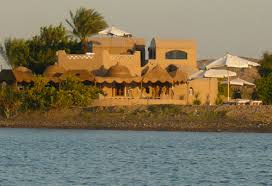
The city of Aswan has an active cultural center in the Corniche devoted to the Nubian culture and music. Every night Nubian dancers and musicians perform typical dances, full of colors and rhythms, from the Nubian and the Egyptian Folklore

The city of Aswan has an active cultural center in the Corniche devoted to the Nubian culture and music. Every night Nubian dancers and musicians perform typical dances, full of colors and rhythms, from the Nubian and the Egyptian Folklore

It is believed to have been built by Queen Hatshepsut of the 18th Dynasty. It lies on the south side of Elephantine Island. Khnum wa

Agha Khan Mausoleum lies on a hill on the West Bank of the Nile, at Aswan. Here, Agha Khan III (1877-1957), the 48th Imam (

Because of the saturation of the Old Dam, which was raised two times after its inauguration, it was decided to build a new dam 6 ki

The Ancient Egyptians used to extract the granite used in the noble parts of their constructions (pyramids, sanctuaries, altars, st

On the road to the airport and Philae Island, and in front of the Nubian Museum, the tourist can see the Fatimid cemetery, which da

The City of Aswan lies on the east bank of the River while on the west bank, the desert almost touches the river interrupted some t

Sarenput II was the Overseer of the Priests of Khnum and Commander of the Garrison at Elephantine during the reign of Amenemhet II

Herkhuf was an Overseer of the troops and campaign commander in Upper Egypt during the reigns of Pepy I, Merenre and Pepy II in Dyn

Mekhu and Sabni were father and son, both were governors of Upper Egypt during the reign of Pepi II of the 6th Dynasty. The reliefs

It lies sixty-two kilometers to the north of Aswan and it is one of the best well preserved stone quarries of the Pharaonic Era. Here, the A

The original site of the temple is the Island of Philae which disappeared under the waters of the middle lake between the Old Dam and the Hi

Outside the city, just south of Aswan High Dam and very close to the Kalabsha Temple, Beit (Beyt) el-Waly is found. This is not the

The island was given to Lord Kitchener as a gratitude for his services in the Sudan Campaign (1896-1898). Kitchener transformed the small isla

It is the largest island in Aswan. Since the Old Kingdom, the island has been considered a sacred place where god Khnum, who was the potter de

Perhaps one of the most enduring images of Egypt is the Nile flowing by the veranda of the Old Cataract Hotel. The palace was built

The monuments of the old Talmis, which was the name of the original site of Kalabsha now disappeared under the waters of Nasser Lak

Kertassi Temple is located to the south of Kalabsha Temple near Aswan . It was dedicated to Hathor and Isis and it is one of the Nubian monu

The Monastery is located behind a hill, in the West Bank of Aswan, in front of Elephantine Island. It is usually visited by tourist

The Nilometer at Elephantine Island, in Aswan was used since the Pharaonic Era to measure the water level of the Nile, up to the ni

Aswan Market is located near the Nile river valley and offering you a unique pleasure to shop in Aswan. It is a heaven for all those who hav

The Dekkah Temple is located about 100 kilometers south of Aswan High Dam in the Historical Nubia. It was moved to the site of el-Sebua, abo

The Nubia Museum was designed by the Egyptian architect Mahmoud al-Hakim and the Mexican architect Pedro Vasquez Ramirez who design

Draw is a beautiful town situated south of Kom Ombo, in the governorate of Aswan. The town is famous for its camel market, where more than

Wadi El Sebou Temple was built by Setau, Viceroy of Kush (Nubia) in honor of Ramses II. The name Wadi el-Seboua means the Valley of